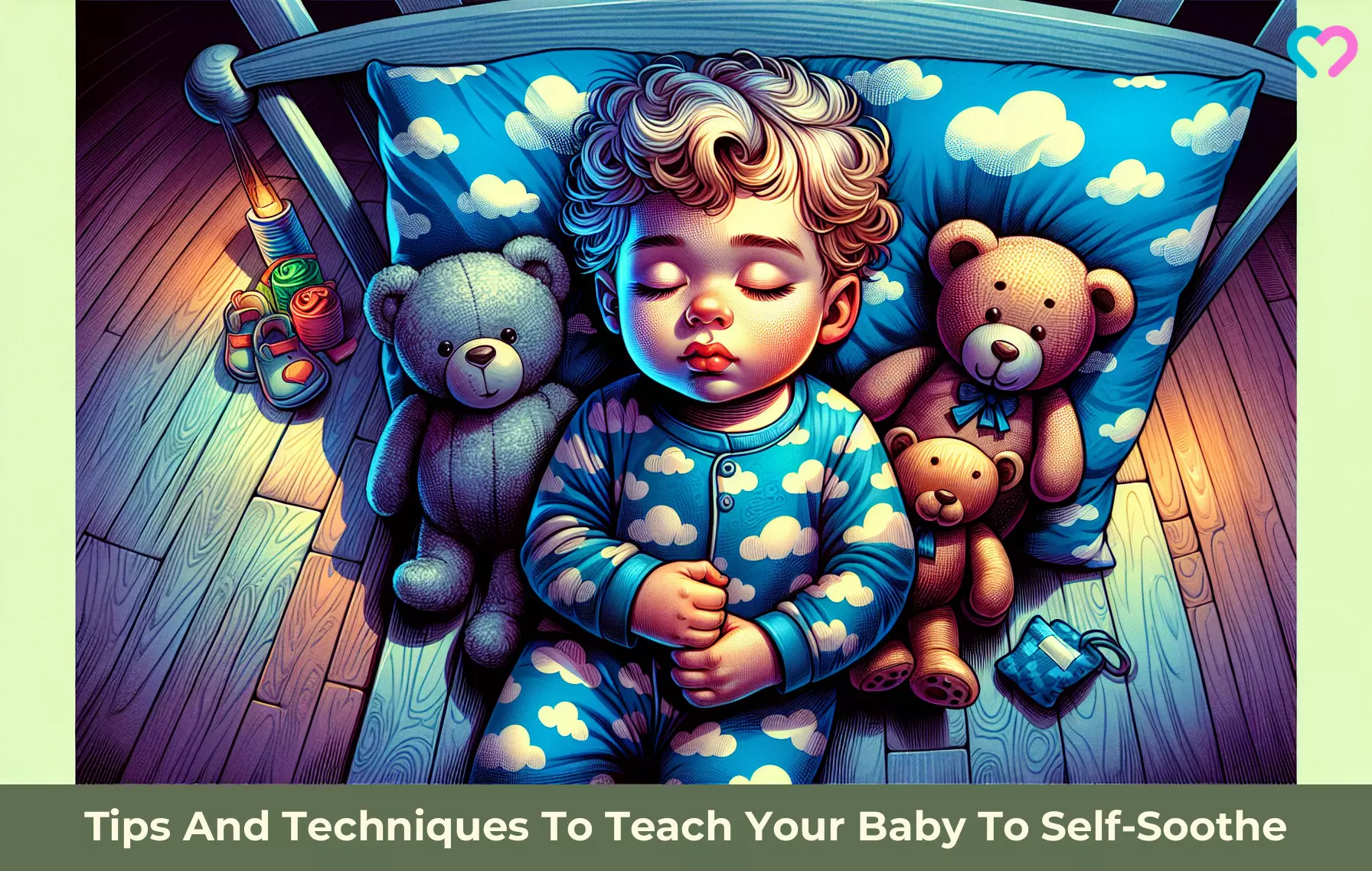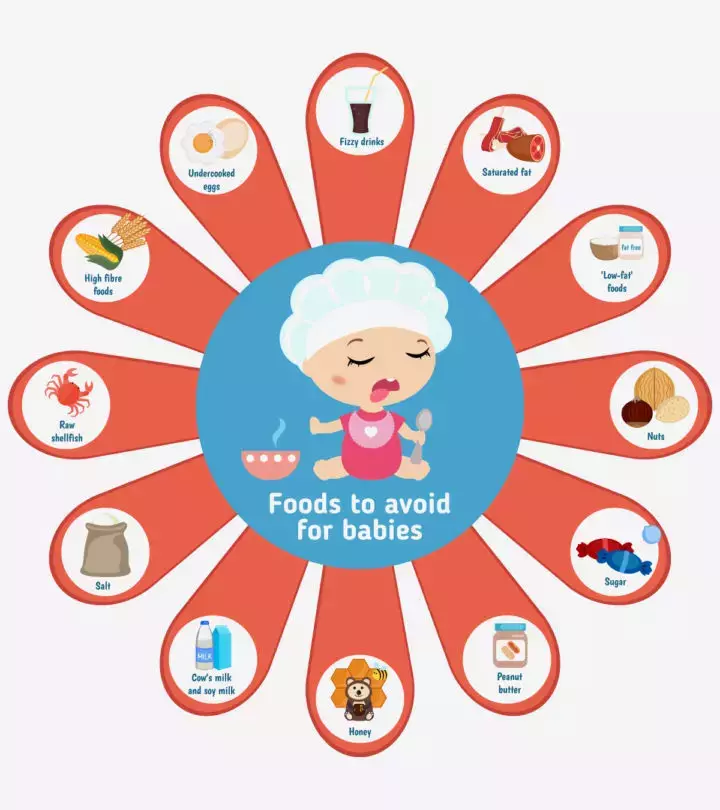
Image: Shutterstock
Self-soothing refers to a baby’s ability to fall asleep without needing a parent/caregiver to rock, cuddle, pat, or carry them. A few babies can self-soothe naturally, while others need to be taught. There are different ways you can teach a baby to self-soothe. However, starting at the right age is crucial. Self-soothing teaches your baby to control and regulate their emotions, which even adults do in their daily lives (1) (2). Hence, using the right self-soothing techniques also matters. Generally, babies learn self-soothing between four and 12 months, though some may take longer to learn the subtle art. Research suggests that one of the vital factors that help an infant sleep through the night is their ability to self-soothe during the first four months of life (3). Read on as we tell you more about different self-soothing techniques, the right age to use them, how to use them, and precautions to take while teaching a baby to self-soothe.

Key Pointers
- Teaching self-soothing helps babies to regulate their emotions.
- Self-soothing techniques usually involve swaddling, movement, or using hands and face.
- You can train your baby to self-soothe after they are three months old.
- Self-soothing also helps babies sleep better and gives the mother time to relax.
- Using a musical crib toy and maintaining a calm routine can help with this technique.
What Does Self-Soothing Involve?
Self-soothing involves behavioral techniques to help the infant manage their sleep cycles
(4). The choice of technique depends on various factors, such as the baby’s temperament and personality (5). This simply indicates that what may work for someone else’s baby may not work for yours. Similarly, soothing strategies may also vary depending on which caregiver a baby is with, for instance, what may work for one parent may not work for the other.
1. Using the baby’s hands, mouth, and face
A few of them are:
- Sucking thumb
- Sucking on pacifiers
- Holding hands together
- Stroking and fondling the ears or nose
- Gently rubbing eyes
- Sucking on bottle
- Sucking a soft blanket, dummy, or a toy
2. Movement, touch, and vibration
It includes:
- Rocking from side to side to get the baby to sleep
- Stroking hair or playing with locks of hair
- Humming a soft melody or playing white noise
- Gently massaging their back
- Stroking comfort objects like a teddy or a blanket
3. Swaddling

Swaddling involves wrapping a blanket snugly around the baby’s body. This arrangement provides the warmth and comfort similar to that of the mother’s womb and is the most suitable way to soothe your newborn baby. The American Academy of Pediatrics suggests that swaddling can be an effective technique to help soothe infants and facilitate sleep, provided done correctly (6).
Note: Don’t use swaddling if your baby is two months or older, and especially, can roll over on their own, as swaddling at this stage may increase the risk for SIDS (7).
4. Self-exploration
Self-exploration is another simple way to help your baby self-soothe. Let them derive pleasure from simple self-initiated acts or movements. Most mothers tend to remove their baby’s fingers from their mouths the minute they begin to suckle. Avoid it.
When To Teach Your Baby To Self-Soothe?

The American Academy of Pediatrics recommends that the efforts to train your baby to self-soothe may be initiated by three months of age (8). For a more personalized decision, you may consult a pediatrician and plan for your baby accordingly. You can try simple self-soothing techniques once your baby has turned about four months old. If you start too early, your baby might get fussier. Though, if you do it right, your baby will learn to self-soothe in less than a month’s time.
How To Teach A Baby To Self-Soothe?
You can teach your little one to self-soothe in various ways. Do not rush. Take one step at a time and allow your baby’s body and mind to learn and adapt to the new skills. Slowly progress from having to hold, rock, swing, and co-sleep with your baby to putting your baby to sleep through self-soothing. The power of the technique lies in taking one step at a time without overdoing the steps or overstimulating the baby.
Calm Baby Method
Step 1: Make eye contact with the baby and talk with them for a few minutes.
Step 2: Make physical contact with them by touching their chest and belly. Then, fold their arms in and legs up towards the belly and roll them onto their side. Keep them in this position for a few minutes.
Step 3: Once the baby is comfortable, pick the baby up and hold them close to you for a few minutes before rocking the baby until they seem calm.
Step 4: If the baby seems sleepy at this point, you may put them down. If required, provide the baby with a pacifier or help them find their thumb to self-soothe.
However, if the baby continues to remain alert or fussy, check the baby for wet diapers or hunger cues and address any needs before swaddling. Repeat the steps until the baby learns to calm themselves to sleep (9).
The Camping Out Method
Step 1: Place your drowsy baby in their crib for a nap after their usual bedtime routine.
Step 2: Sit next to the baby in a chair while making sure you are within their line of sight. Stay in your place until the baby falls asleep.
Step 3: Avoid the urge to immediately soothe the baby the moment they start crying or fussing. Observe the baby while reassuring them verbally that you are around. However, if the baby doesn’t calm down after five minutes, place a hand on the baby or pick them up if needed.
Step 4: Over time, gradually increase the distance between the chair and the cot. Allow the baby to soothe themselves and only intervene if necessary. Keep repeating the process until the baby seems content enough with your mere presence in the room.
Step 5: Once the baby begins to fall asleep by themselves, move out of sight and keep an eye on them without any contact unless absolutely necessary (19).
Gentle baby self-soothing
It involves the following steps:
Step 1: Prepare yourself to be ready to let go. This is perhaps the most difficult step for you as a parent.
Step 2: When you are ready to teach self-soothing, put your baby down a bit earlier than usual; just a minute or two before the baby falls into a deep slumber in your arms.
Step 3: Gradually advance the stage at which you put your baby down: from asleep to half asleep and then finally, when the baby is still awake. You should be patient and keep trying it several nights until your baby is ready. Eventually, your baby will sense your intention and plop into sleep on their own!
The eight-day trial
Days 1-4:
Choose a toy or a blanket, which brings a smile on the baby’s face. Train your baby to use it as a soother.
Days 5-7:
Let the little one get used to the new pattern. As the baby develops an association with the blanket or toy, you can start using these items that your baby can fiddle with and use to fall asleep. Whenever your baby begins to cry at night, give the same items instead of patting or nursing them. This step can be challenging and requires patience.
Day 8 – The big day:
On day eight, drop the soothing tool in the baby’s crib instead of giving it to the baby to hold. If the baby wakes up at night and begins to fuss, do not jump in. Leave them for about five minutes, and they are likely to find the prop and use the same and fall asleep by self-soothing.
 Quick tip
Quick tipBenefits Of Self-Soothing

The proponents and supporters of self-soothing method argue that it has benefits for the baby, such as:
1. The baby becomes less fussy
Self-soothing not just helps your baby sleep better, but also teaches them self-control. A baby who can self-soothe is likely to be less fussy and relaxed through the day (10). If you, as a mother, can promote independent sleep associations during the night, you will find your child a lot more active and less cranky the next day.
2. They sleep better
If your infant can self-soothe while still in a light sleep state, the chances are that they will be able to sleep without your intervention. This suggests that the baby may be able to go back to sleep without any intervention when they wake up in the middle of the night. Gradually, your baby will learn to sleep longer without waking you up.
3. They grow confident
Your baby’s ability to self-soothe also impacts how they control their emotions. It will help them regulate their moods, positively impacting their focus on learning new skills with confidence (11).
4. The mother gets to relax
If you can teach your baby to self-soothe, your days and nights will be a lot more settled, and you can carry out your daily chores without too many breaks. It is a lot easier to care for an infant who can self-soothe than for a fussy baby who requires constant interventions just to sleep for a few hours at night.
Tips To Make Your Baby Self-Soothe
If you are convinced of this method and want to try it on your baby, these tips might be of some help to you (12) (13).
1. Use a musical crib toy
Music can be a great soother. Studies suggest that white noise might help in putting infants to sleep (14). So, you can try attaching a mobile musical toy to your baby’s crib. These sensory toys play melodies such that will help your baby fall asleep. Many of these toys also have a projector and chimes that will add to the soothing effect.
2. Have a consistent bedtime
Establishing regular bedtime routines is vital as this sets an internal clock that helps your baby feel sleepy at a predictable time. Make sure it is not too late in the night, as this could disturb your baby’s routine and make them fussy. If your little one is too overwhelmed to settle down on their own, try moving the bedtime further.
3. Maintain a calming night routine
A calming night routine helps the little one understand that it is time to go to sleep. The routine may include activities like reading bedtime stories, a bath, singing a lullaby, or cuddling. To maintain a sense of calmness and peace while your baby sleeps, it’s important to keep interactions low and the lights dim at night. Even minor disturbances can jolt your baby from sleep, especially until they are 12 weeks old.
4. Give enough time
To teach your little one to fall asleep without your intervention, put them on the bed while they are still awake but drowsy or show the usual baby sleep cues. Sleep training is not a simple task, so give the baby enough time to get used to sleeping by self-soothing. Be patient and remember that some babies take more time than others. Your baby may still be building the ability to self-soothe, so do not compare and stress.
5. Be observant
Some babies are rather sensitive, and the slightest change in temperature, light settings, or even noise can disturb them. If your baby wakes up too often at night, check if anything specific is disturbing the sleep.
6. Be present around
Your presence can just do the trick. Instead of carrying your baby and putting them to sleep, you can stay close to the crib or walk in the room. Your presence may be all that your baby needs to self-soothe and sleep.
 Quick tip
Quick tipDos And Don’ts Of Self-Soothing

Even as you follow the above tips, you need to check on some important dos and don’ts of self-soothing.
1. Be patient
Control yourself from intervention. Check if you are getting in the way by rocking your baby to sleep or comforting at the first cry or forcing the baby to sleep out of the routine. It is important that you give your child ample time to try and settle in bed. Often, a baby fights sleep, groans, and moans a bit, and then settles down. Unless your baby is crying, give them some time to figure out things on their own. In the case of incessant sobs, respond and try to find the reason for your baby’s stress.
2. Stop feeding to sleep
You are definitely not helping your baby learn self-soothing if your baby falls asleep while breastfeeding or bottle-feeding. Gradually stop the habit, starting by shortening the time you spend feeding and eventually moving the feeding time away from bedtime.
3. Avoid consistent soothing
Avoid consistent soothing by rocking, patting, or nursing your little one. Instead, try other ways, like, kissing them goodnight and walking out. Stand outside the nursery so you can observe them from a distance. Soon, the baby may learn to sleep on their own without much fuss.
4. Break these habits
Here are some habits you should avoid while teaching your baby to self-soothe.
- Putting your baby in a pram or buggy to facilitate sleep.
- Using a pacifier to stop crying and facilitate sleep.
- Allowing your baby to stroke your tresses and fall asleep.
The real challenge lies in breaking these habits. Once you are able to break them, it will be easy to help your baby learn to self-soothe fast. But, remember that this is necessary only for babies older than six months. Until your baby turns six, do not worry about the napping habits getting ingrained.
 Quick tip
Quick tipAlternatives For Self-Soothing In Babies
Self-soothing requires parents to stop intervening when the baby wakes up crying. So, immediate responsive parenting is an alternative for self-soothing. Here, the parents immediately react to their babies’ cries and attend to their needs through rocking, feeding, or other comforting soothing methods.
How Long To Let The Baby Cry if They Won’t Self-Soothe?
There is no fixed time to leave your baby crying. It depends on you and the circumstances. For instance, if you are attempting a self-soothing approach for the first time or the baby is unwell, you might want to attend to their cries sooner. You may also try the ‘Ferber method,’ where you can gradually increase the time you let the baby cry before intervening (17).
Points To Remember
- A baby who has learned self-settling and coping skills can be left awake, and they will sleep on their own.
- Do not get worked up and frustrated if your baby does not learn to self-soothe at the end of eight days.
- Do not force things the wrong way as this can be overwhelming for both of you and can also hamper future success.
- Set the stage right. Practice the new skill with your baby a few times before you let them practice these skills on their own.
- Simply putting your baby down on the cot may not always work. Use well-defined progressive techniques and exercises. Remember, a lot can be achieved through gentle ways.
Taking these simple measures can help your baby learn the self-soothing technique easily. It is a skill that will help them not just to fall asleep but also to avoid situations like separation anxiety or frustration. Be patient while you help the baby practice them and understand that the baby is too young to understand things fast.
Frequently Asked Questions
1. What to do if the baby does not self-soothe?
Most babies learn quickly and begin to drift to sleep without much fussing or protesting. But a few can be stubborn. Older babies who are habituated to being nursed or patted to sleep will take some time to grow out of their habits. In such cases, make it a gradual process.
It is better to follow your instincts instead of doing something you feel will not work or can be detrimental to your baby. Observe your baby and follow simple techniques that could work for both of you. No one method works for every newborn.
2. What if my baby can’t sleep without nursing?
To help infants who are accustomed to being nursed to sleep, it’s necessary to gradually eliminate this habit. This can be done by either feeding them well before bedtime or reducing the length of nighttime feedings. This process may take time, particularly for babies over eight months old. Be patient and persistent in your efforts to establish a new sleep routine for your baby.
3. Is crying a self-soothing behavior?
Crying is a way for babies to communicate their needs and emotions. It can be a self-soothing behavior that helps them release built-up tension and feel better emotionally. So, it is normal for babies to cry and express themselves through crying (18).
4. What if my baby cries excessively during self-soothing training?
When practicing self-soothing training, it’s normal for babies to cry, but excessive crying can be distressing for both parents and infants. Start by checking on your baby at slowly increasing time intervals, making sure they’re safe and not in real pain. Watch for signs that the crying might indicate a deeper issue, like hunger or illness. Remember that every baby is unique – some learn to self-soothe quickly, while others need more time and gentle support. Stay patient and consistent, and maintain a calm environment. If the crying seems excessive or worries you, consult your pediatrician to rule out any medical concerns.
Allowing your baby to self-soothe is a skill you should teach them from as early as four to 12 months. It involves behavioral techniques like letting them suckle on a thumb or pacifier, stroking and rubbing the ears or nose, swaddling, swinging, etc., to help the baby manage their sleep. This helps babies sleep better, feel less cranky, and allow parents to unwind and relax. However, when babies learn to sleep independently, keep an eye on them to make sure they’re okay but avoid disturbing their sleep.
Infographic: Helpful Self-Soothing Techniques For Babies
Teaching babies to self-soothe is a crucial skill so they can relax and go to sleep on their own. It can also benefit parents, allowing them to relax and enjoy some alone time. The infographic below includes tips on teaching your infant to soothe themselves. Explore!
Some thing wrong with infographic shortcode. please verify shortcode syntax
Illustration: Tips And Techniques To Teach Your Baby To Self-Soothe

Image: Dall·E/MomJunction Design Team
References
- Asmir Gračanin et al.; Is crying a self-soothing behavior?; National Center For Biotechnology Information (2014)
https://www.ncbi.nlm.nih.gov/pmc/articles/PMC4035568/ - Sample text for Healthy sleep habits happy child; Library of Congress
https://catdir.loc.gov/catdir/samples/random042/98044684.html - Jacqueline M. T. Henderson et al.; Sleeping Through the Night: The Consolidation of Self-regulated Sleep Across the First Year of Life; American Academy of Pediatrics (2010)
https://pediatrics.aappublications.org/content/126/5/e1081 - Sleep baby sleep; APA
https://www.apa.org/monitor/feb04/sleep - Beth L. Goodlin-Jones; Night Waking Sleep-Wake Organization and Self-Soothing in the First Year of Life; National Center For Biotechnology Information (2001)
https://www.ncbi.nlm.nih.gov/pmc/articles/PMC1201414/ - Swaddling: Is it Safe?; American Academy of Pediatrics (2017)
https://www.healthychildren.org/English/ages-stages/baby/diapers-clothing/Pages/Swaddling-Is-it-Safe.aspx - Newborn Sleep Patterns; John Hopkins Medicine
https://www.hopkinsmedicine.org/health/wellness-and-prevention/newborn-sleep-patterns - Ian M. Paul et al.; Insight Responsive Parenting Intervention and Infant Sleep; American Academy of Pediatrics (2016)
https://pediatrics.aappublications.org/content/138/1/e20160762 - Self-Soothing: Help Your Baby Learn This Life Skill; American Academy of Pediatrics
https://www.healthychildren.org/English/ages-stages/baby/crying-colic/Pages/Self-Soothing-Helping-Your-Baby-Learn-This-Life-Skill.aspx - Anna Sidor et al.; Influence of early regulatory problems in infants on their development at 12 months: a longitudinal study in a high-risk sample; National Center For Biotechnology Information (2013)
https://www.ncbi.nlm.nih.gov/pmc/articles/PMC3854693/ - Janis Baird et al.; Infant Sleep Disturbance Is Associated with Preconceptional Psychological Distress: Findings from the Southampton Women’s Survey; National Center For Biotechnology Information (2009)
https://www.ncbi.nlm.nih.gov/pmc/articles/PMC2663867/ - Getting Your Baby to Sleep; American Academy of Pediatrics (2018)
https://www.healthychildren.org/English/ages-stages/baby/sleep/Pages/Getting-Your-Baby-to-Sleep.aspx - Infant Sleep; Department of Neurology; Columbia University
https://www.neurology.columbia.edu/patient-care/specialties/child-neurology?id=36578 - J A Spencer et al.; White noise and sleep induction.; National Center For Biotechnology Information (1990)
https://www.ncbi.nlm.nih.gov/pmc/articles/PMC1792397/ - What is Self-Soothing? Learn About this Important Social-Emotional Tool; Pathways.org
https://pathways.org/self-soothing/ - Baby sleep and settling at 3-6 months: tips; Raisingchildren
https://raisingchildren.net.au/babies/sleep/settling-routines/helping-babies-sleep-settle-3-6-months - The Ferber Method for Sleep Training.
https://www.sleepfoundation.org/baby-sleep/ferber-method - Is crying a self-soothing behavior?
https://www.frontiersin.org/journals/psychology/articles/10.3389/fpsyg.2014.00502/full/full - Sleep Training.
https://www.sleepfoundation.org/baby-sleep/sleep-training
Community Experiences
Join the conversation and become a part of our nurturing community! Share your stories, experiences, and insights to connect with fellow parents.
Read full bio of Dr. Edward Kulich
Read full bio of Swati Patwal
Read full bio of Rohit Garoo
Read full bio of Vidya Tadapatri


















